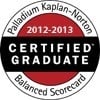Figuring out how much to spend on marketing can feel like throwing darts in the dark. You know you need to invest, but what's the right amount? This is not just about picking a number; it is about crafting a smart marketing spend strategy that fuels your growth instead of draining your cash flow.
Too many business leaders treat their marketing budgets like a guessing game, leading to wasted marketing efforts. A proper marketing spend strategy ties every dollar to a specific, measurable business goal. It thoughtfully connects your capacity to deliver with the demand you create.
Use Our Hubspot Inbound Marketing and Sales ROI Calculator to Find out the ROI you can Get From Using Hubspot Inbound Marketing and Sales Software.
Times Have Changed, And So Has Marketing
I often think back to my dad. He was a water well driller here in Southern Indiana, a tough, honest job. His marketing planning was simple and, for his time, effective.
For nearly 40 years, he ran a small ad in the Yellow Pages that cost about $40 a month. He had some business cards and magnetic signs for his truck. Most of his business came from that ad and word-of-mouth referrals.

He ran a one-man operation, and his core business was limited by his capacity. He never really had the desire to grow beyond what he could handle himself. For him, a simple plan was enough because he had a simple business model.
Today, the game is completely different for any specific business. The modern digital marketing landscape presents dozens of marketing channels, from Google and LinkedIn ads to content marketing and social media. Creating a cohesive digital marketing strategy requires careful consideration and budget allocation across these options, making it easy to waste money without a solid plan.
Your Biggest Marketing Mistake: Ignoring Capacity
My dad's business highlights a point many entrepreneurs miss. Your marketing spend must be balanced with your capacity to deliver. It makes no sense to generate 100 new customers if you can only serve 10.
He used an old "cable tool" rig he bought for about $2,700. In perfect weather, it could drill a 150-foot well in about three days. Because of Indiana weather and equipment breakdowns, he realistically drilled about 20 wells a year.
His capacity was low, impacting his gross margin on each job. His maximum potential income was around $30,000 a year from drilling. He did not need a huge budget because he could not have handled the extra work anyway.
Now, let's look at the alternative he considered but never bought: a modern rotary drill. A new one, fully equipped, would have cost around $500,000. That sounds like a crazy amount of money for a small services business, and it is.
But that rig could drill two 150-foot wells every single day, year-round. It could operate in any weather. This new machine represented a massive leap in capacity, which would require a complete overhaul of his business strategy.
This is where capacity and demand generation connect directly to your marketing activities. With the ability to drill 10 wells a week instead of one, my dad would have needed a massive increase in leads. His $40-a-month ad would not cut it anymore.
Evaluating capacity is about more than just equipment. It involves assessing your marketing team, your human resources for fulfillment, and your technology stack. For companies with physical products, it even includes your supply chain and product development timelines.
A Smarter Marketing Spend Strategy
So, how do you determine marketing spend? The most common advice you will hear is to use a percentage of your revenue. This top-down approach is not a bad starting point, especially if you have no other data sources.
For example, a Gartner CMO Spend Survey often provides a cmo benchmark for various industries. Spending levels can vary greatly, from 5% to 12% of revenue. An established business like my dad's might stay on the low end, while a fast-growing software company might spend closer to 30% to capture market share.
Budget allocations will differ based on your industry and growth stage. Let's explore a few examples.

| Industry Sector | Typical Marketing Spend (% of Revenue) | Focus Area |
|---|---|---|
| Consumer Packaged Goods (CPG) | 10% - 20% | Brand awareness, retail partnerships |
| B2B SaaS (Growth Stage) | 15% - 30% | Demand generation, lead nurturing |
| Professional Services | 5% - 10% | Reputation, relationship building |
| E-commerce | 8% - 15% | Customer acquisition, digital ads |
Let's go back to the drilling example. The new rotary rig had the potential to generate over $150,000 a year in revenue. Using a 10% rule, that business would need marketing investments of around $15,000 per year for marketing costs.
That $15,000 would be spent to make sure the phone rang often enough to keep that expensive rig busy. It's a completely different mindset that comes with budget management. The budget is a marketing investment in maximizing the capacity you paid for.
Work Backwards From Your Real Goals
A simple percentage is fine, but there is a much better method. The best approach, often called bottom-up budgeting, is to work backwards from your revenue and profit targets. This connects your marketing spending directly to the results you want and is a core principle of revenue marketing.
Let's use an example for a consulting business. Say you want to hit $2.5 million in gross revenue with a goal of $1 million in net profit. Effective marketing budget management starts with clear financial analysis.
First, you know your target revenue is $2,500,000. If your average deal size or average order value (AOV) is $100,000, you know you need to close 25 new customers this year. This simple calculation frames your entire sales and marketing strategy.
Now, you need to know your sales conversion rate. Let's say you know you close about 2% of the qualified leads you generate. To get 25 customers, you would need to generate 1,250 leads for the year (25 customers / 0.02 conversion rate).
If you use our 10% rule of thumb on the $2.5 million revenue goal, your marketing budget is $250,000. This now gives you a critical number: your maximum allowable cost per lead. By dividing your budget by the number of leads, you get $200 per lead ($250,000 / 1,250 leads).
That $200 per lead becomes your guardrail. As a digital marketing specialist, I know that if I can generate leads for you under that $200 threshold, every dollar we spend is profitable. This is how you build a predictable sales pipeline and improve financial performance.
Remember, this cost per lead must account for the total cost. It is not just ad spend, but also your marketing technology, content creation, and staff salaries. You can use various planning tools to model these scenarios and track progress against your goals.
When To Spend As Much As You Can
This data-driven approach leads to a powerful conclusion. Once you build a system that works, the answer to "how much should I spend?" becomes very simple. You should spend as much as you possibly can, as long as your marketing efforts remain profitable.
If you have a machine where you can put one dollar in and get two dollars back out, the only real limit is your cash flow. This is how businesses accelerate growth quickly and effectively. Managing marketing is no longer about a static budget, but about fueling a growth engine.
Of course, this only works if your numbers are solid and you understand your target audience deeply. You have to track marketing metrics and sales funnel conversion rates closely. You also need to be prepared with scenario planning, as market conditions and marketing costs can change.
Your Competitors Are Already Watching
If you have found a profitable marketing channel, you should assume your competitors already know about it. The world's leading companies constantly monitor the marketing field. Tools like SEMrush give anyone a look into what their competitors are doing online.
As someone certified on these platforms, I use them all the time to spy on competitors. I can see which keywords a competitor is targeting and view their marketing messages. This type of analysis offers powerful business insights.
This means your competitors can see what you are doing, too. It can be very expensive to get into a bidding war over the same keywords and customers. Just copying your competitor's marketing strategies is usually a losing proposition for most business leaders.
So what is the best way to optimize marketing spend? Do not just copy their ad; build a better offer. Instead of just trying to outspend them, give the customer a better reason to choose you. This is always a smarter and more sustainable way to grow.
A superior strategic marketing plan focuses on improving your value proposition. Understanding marketing means focusing on what your customers truly need. When you do that, your marketing becomes much easier and more effective.
Marketing leaders in North America and beyond stay up-to-date on industry trends. They use this information not just to react, but to proactively shape their own marketing strategy. This approach helps them optimize marketing outcomes and stay ahead.
Conclusion
Developing a marketing spend strategy is more than just allocating funds from business finance. It is about building a predictable system for growth that is tied to your real-world business capacity and your revenue targets. You need a data-driven plan, not a guess, to make sound marketing investments.
Start by understanding your operational limits, then work backwards from your financial goals to determine what you need. Track your numbers closely, from cost per lead to customer acquisition cost. When you create an effective marketing spend strategy, you can confidently invest to scale your business.
We are a full-service Hubspot Certified Inbound Marketing and Sales Agency. In addition, we work to integrate your SAP System with Hubspot and Salesforce, where we have a deep delivery capability based on years of experience. Please our book a meeting service to get started.




